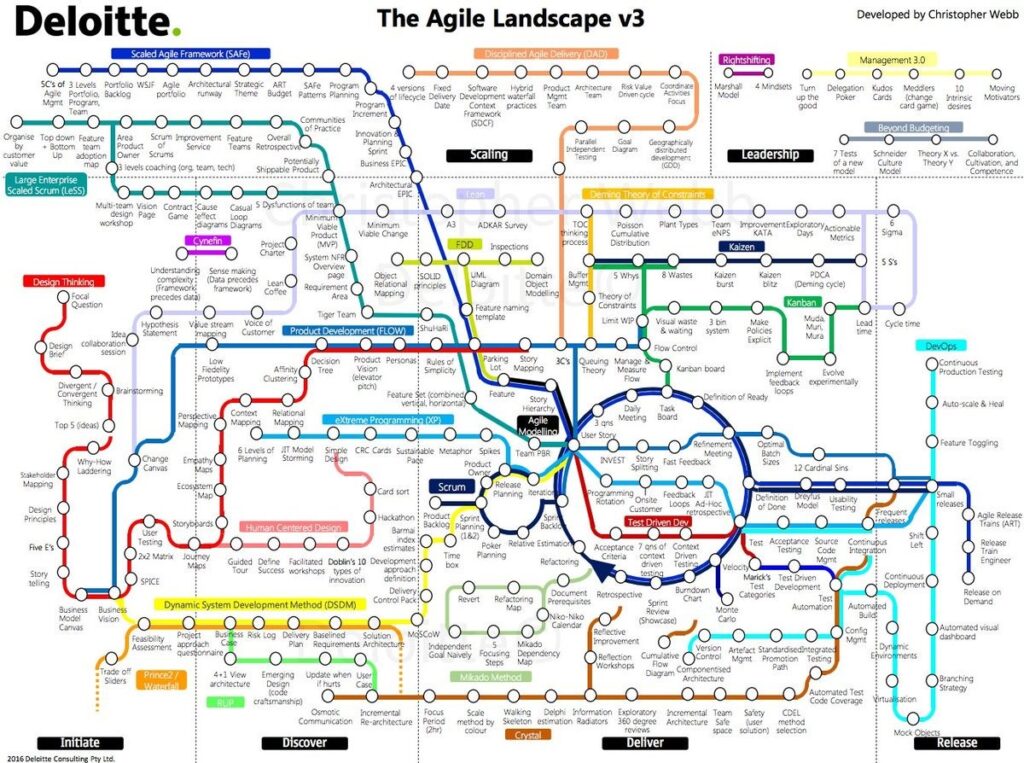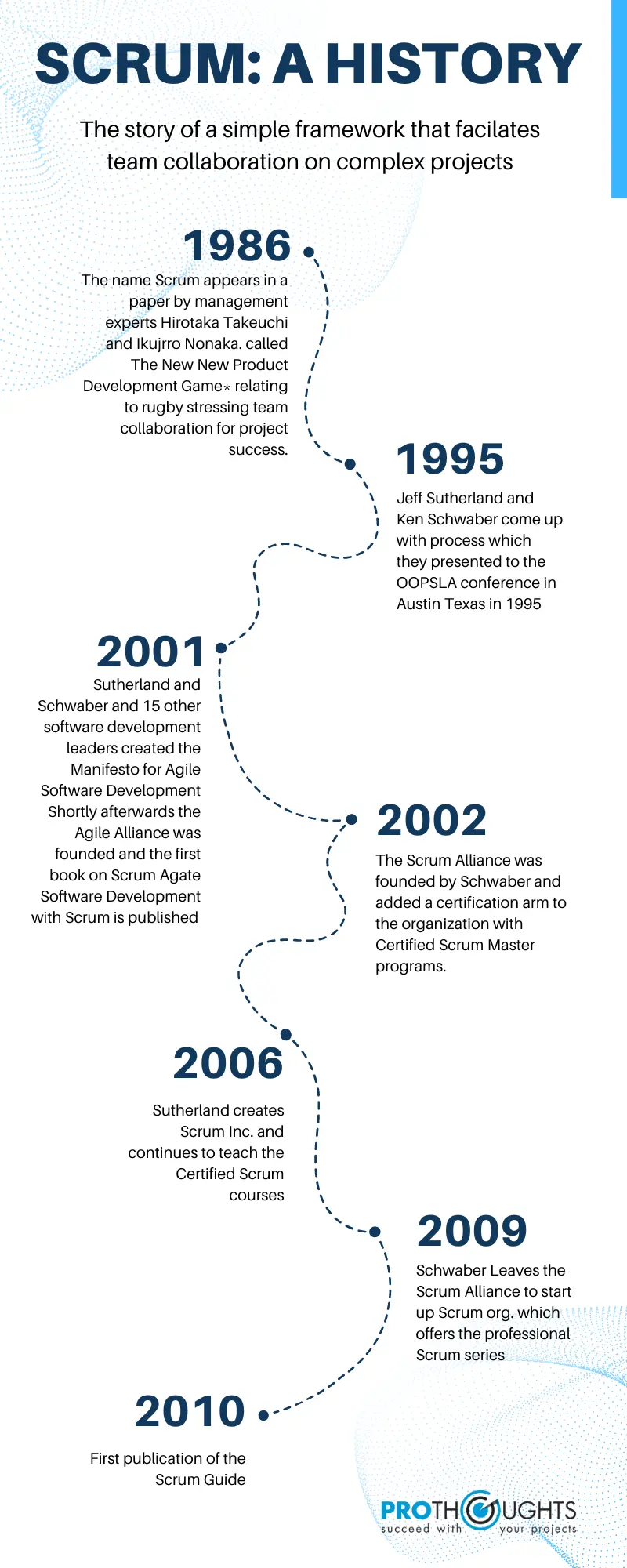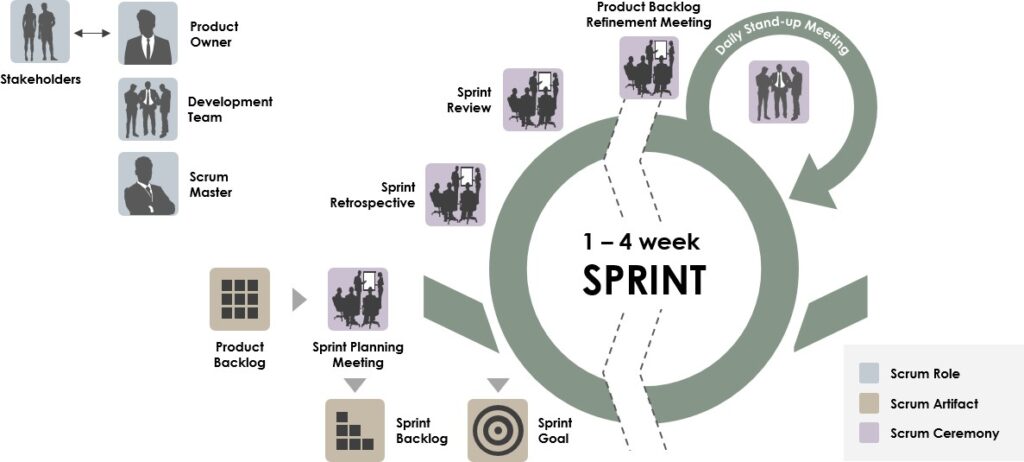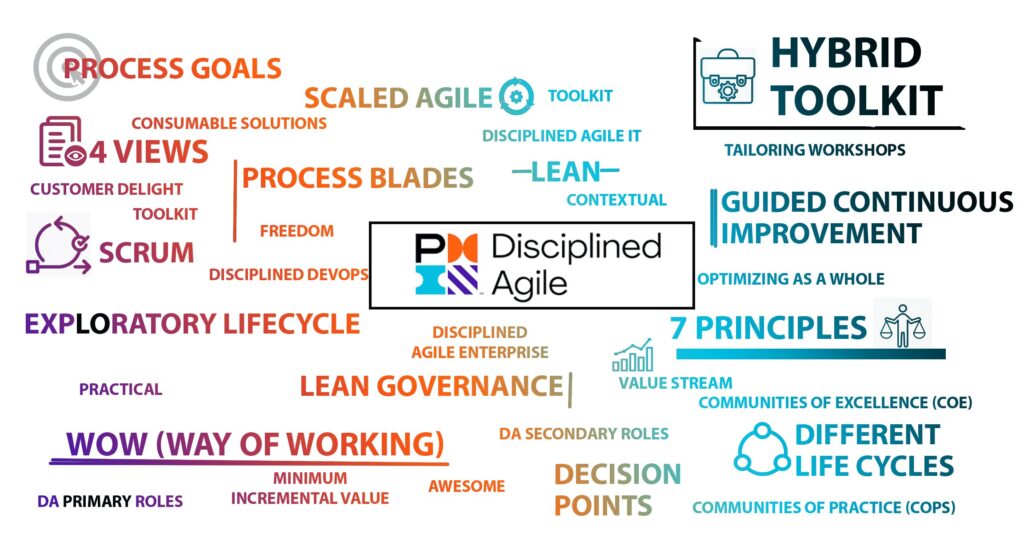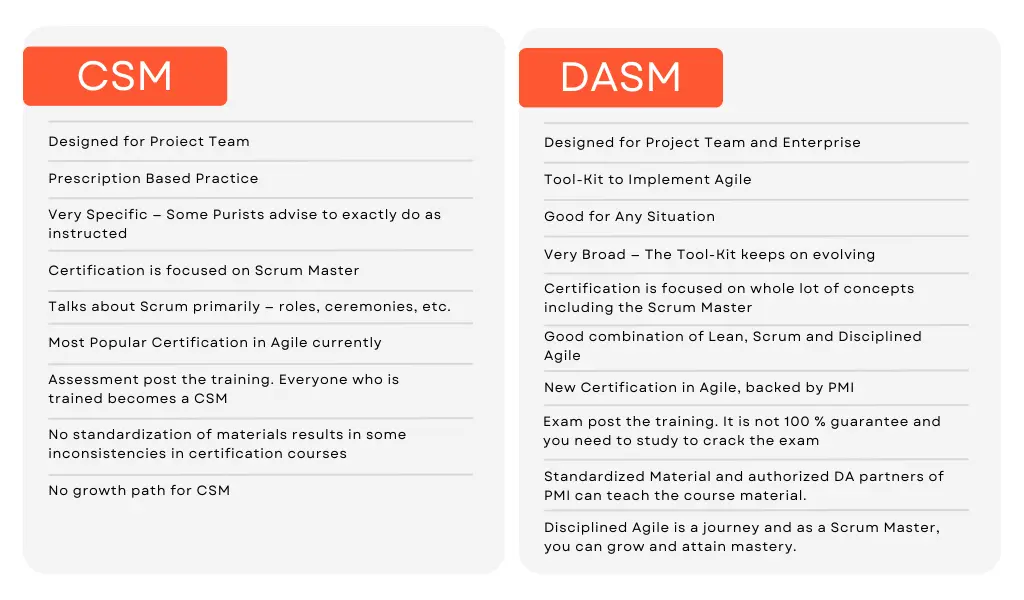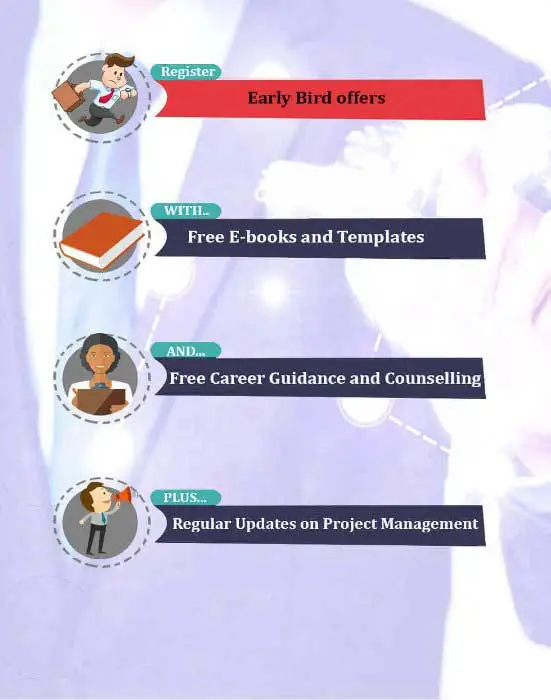 Any idea why Agile is gaining popularity? As per the Version One Survey results, various reasons can be identified. But, one thing that stands out to me is “Being Agile” is a function of the environment we are working in. Today, the environment has become more volatile and complex and therefore, the value delivered at the soonest time has taken precedence. The below article will also give good details on the differences and similarities between DASM and CSM. And it will probably help you to make your own choice.
Any idea why Agile is gaining popularity? As per the Version One Survey results, various reasons can be identified. But, one thing that stands out to me is “Being Agile” is a function of the environment we are working in. Today, the environment has become more volatile and complex and therefore, the value delivered at the soonest time has taken precedence. The below article will also give good details on the differences and similarities between DASM and CSM. And it will probably help you to make your own choice.
My take is that Agile firms will dominate in the future. Every business, be it software or non-software (Btw, every business today is software) will have to be Agile. And by being Agile, it is not doing Scrum or XP or DASM or any practice, but having the mindset of Agile.
Let’s explore Agile in our own little way before exploring the DASM vs CSM
Agile is a huge canvas, and it has given a multitude of practices and methodologies. If you see the landscape prepared by the popular Deloitte Consulting firm, you can see almost 100 practices of Agile and for a beginner in Agile, it is too overwhelming.
It is a humungous landscape. Agile throws different situations and different possibilities. Right from a small firm or a small team to a large global organization wants Agility. Does one solution work for all? Or are we talking of multiple solutions and practices for multiple teams? One Agile solution may not work for all teams and for all situations, as you may have witnessed already. And that’s one of the reasons why Agile has transformed into such a huge landscape with multiple practices and methods.
The Scrum Master certification will therefore become important and with this article, I am going to explore the differences and similarities between the most popular Scrum Master – DASM vs CSM
Before exploring both these certifications, I have explored Agility and why people look for Agile solutions briefly. Further, I have tried to differentiate between Methodology, Practices, and Tool-kits to explain the Scrum Master Certifications better. And finally, I have delved deeper into both DASM vs CSM.
And last but not least, I have explained the differences between DASM vs CSM in a nutshell.
Why are there more things to Agile?
It will be difficult to determine if one approach will suit you. And it is just doing Agile – it is about a cultural transformation and a mental paradigm shift I am referring to.
If you talk of the Agile Manifesto, does not prescribe any specific methodology; it provides a set of values and principles on which agile methodologies are based.
We often talk about methodologies, practices, toolkits, and techniques – use many terms. But I guess many aren’t sure what exactly they mean by that.
So, what exactly is the methodology?
- Methodology – a set of ideas or processes, or procedures followed over and over to provide or deliver a known result, such as completing a specific project.
The methodology is a repetitive thing that has given you the results. A methodology is particularly unique to you or your team and has proven successful to the team in question, in that particular context or situation. Isn’t it? - Practices – These are specific rules and guidelines to follow during the course of undertaking and managing projects.
So, practices are followed by others, and these guidelines work universally well and are proven to help you succeed with your projects. - Tool-Kit – enables to take decisions using Agile practices for Better and more Effective Outcomes
So, a toolkit is an enabler and leverages the various practices to deliver effective outcomes. Most of your software products/automation are toolkits that enable you to deliver better outcomes.
Knowing all the above, I would make the following statement:
Practice + your adoption (set of rules) = Methodology
Yes, Practice along with your tailoring the practices, guidelines, or processes, as you gain mastery over a period of time, becomes your methodology. This enables better outcomes in your context. The Toolkit if used properly will enable you for much better outcomes in a much quicker time.
And today’s environment values time, isn’t it? The quicker you deliver the right thing (Value) the better you are, on your road to Agility. The sooner you deliver value in a cost-effective way makes you or your organization’s Business Agile.
Having understood the context of practices, methodologies, and tool-kits, along with the Agility and Agile landscape, let’s try to navigate to our main topic, which is dealing with 2 Scrum Master certifications (DASM and CSM).
The most popular practice in the Agile world is Scrum, and the most popular certification is Certified Scrum Master by Scrum Alliance. And now, PMI, which is the most popular and the most networked project management institute, has come with another Scrum Master, which is the Disciplined Agile Scrum Master (DASM). PMI has retained the name “Scrum Master” as the name “Scrum Master” has a wide employability factor, and many organizations look for this role. However, both PMI and Scrum Alliance has way too different approaches to their Scrum Master. The topic is to analyze both of them and give a perspective and difference about both of these Scrum Masters.
-
Certified Scrum Master (CSM)
As I mentioned earlier, CSM is the most popular certification and is there, right from the origins of Agile Manifesto and Scrum. It is the oldest and the most popular certification – It has been around for almost 20 years.
In fact, the origins date back as long as 1986. Two management scholars, Hirotaka Takeuchi, and Ikujiro Nonaka, first presented the term “Scrum” in an article published in 1986 in the Harvard Business Review to describe a framework that makes scalable business agility possible across an organization.
Also in the late 1980s, Jeff Sutherland and Ken Schwaber (both were part of 17 Developers who made the historic Agile Manifesto in 2001) began working separately with Scrum’s hallmark small teams and developed the methodology together in the first half of the 1990s, presenting a paper on it.
So, Certified Scrum Master (CSM) was the 1st certification that advocated Agility. CSM prophesized how Agile can be done by a team.
Essentially, CSM was developed, designed, and targeted for beginners who want to get introduced to the new way of doing Agile. It was the 1st step of getting into the new world and, therefore, had a number of steps (read Ceremonies) to implement Agile.
CSM was the entry point for many Agile beginners between 2010-2020
If we have to dive deep into CSM Certification, the CSM Certification course delves into the following concepts:
- Agile & Scrum – Elucidate Agile and Scrum concepts. The Agile concepts will talk about Agile Manifesto and 12 Agile Principles. Our goal is to gain a better understanding of Scrum Ceremonies and the use of sprints in Scrum.
- Scrum Master Competencies – The CSM focuses on the CSM role on what he is supposed to do in a Sprint. What are his / her competencies in an Agile project?
- Service to Organization / Development Team / Product Team – This section further elaborates on the role of the Scrum Master and how he/she should go beyond the project and serve the organization as well as inculcating Agile values.

1. How does the Agile flow work in a Scrum project?
2. Focus on the Scrum Master role
During a Scrum project, the Scrum Master is primarily involved in the following activities:
- Facilitates Scrum events
- Ensures that everyone on the team has a solid understanding of the goals, scope, and product domain
- Removes obstacles to the team’s progress
- Helps navigate the Scrum team through environments where Scrum is neither fully implemented nor completely understood
- Coaches and leads the organization through the process of adopting Scrum
- Plans Scrum implementation in the organization
- Introduces changes that improve team productivity
- Works with other Scrum Masters in the organization to improve overall Scrum effectiveness
- Service to Product Owner
- Service to the Organization
Primarily, the CSM certification helps to acquaint with the Scrum Master role and also, acquaints with the various ceremonies of the Scrum lifecycle.
However, it does not necessarily equip you to perform the role of Scrum Master for your projects. Further, the CSM exam is not really an exam, but an assessment, as the institute likes to refer to it– the idea of the CSM course was primarily to introduce to the world of Agile and Scrum Master. As the employers wanted Scrum Masters to perform, they introduced the exam after much criticism from the employers.
What is Disciplined Agile?
Disciplined Agile is a new concept introduced in the market in 2012 but was recently acquired by PMI in 2019 and launched again in 2020.
Unlike other Agile offerings is not a practice, but a toolkit that leverages other practices to provide the right guidance, in the context you are operating.
Further, It does not restrict to a team but is designed to bring Business Agility to the entire organization. The PMI-ACP, unlike other Agile certifications, is designed for the team as a whole.
Disciplined Agile recognizes this fact, so it has researched all appropriate practices and selected the most relevant in each context. The teams can then focus on the tasks at hand instead of figuring out which practices and processes to follow.

8 principles
Given the context and understanding of how useful it is for Agile teams.

Using Disciplined Agile, your teams will improve and be more effective in their outcomes over time by evolving their WoW (Way of Working). The focus is to get there sooner than later and the toolkit will help you to better the outcome successfully.
This brings a new wave of thinking and looks very practical for an Agile practitioner to implement.
Because Disciplined Agile is a completely new world, you must progress from beginner to expert to become proficient.
DASM vs CSM
Although both have the same names, they differ a lot in their perspectives. By explaining Scrum practice and the Scrum Master’s role, CSMs introduce beginners to Agile
Team Agility (Tactical Agility) and Enterprise Agility are discussed in Disciplined Agile, as well as Scrum. You can drive Agility for your team and for your organization with disciplined Agile.
Below is the journey of Disciplined Agile. It covers from a beginner’s level to an experienced (Master’s) level.
As a starting point for Agile, Disciplined Agile also recommends Scrum and Scrum Master at the beginner level. Further, at the beginner level, it has Lean principles and foundations along with Disciplined Agile Foundations.
In short, the beginner level (DASM) – Disciplined Agile Scrum Master is a lethal combination of Scrum, Lean, and Disciplined Agile.
This is in a nutshell the journey to Business Agility.
My Take:
The choice between DASM vs CSM boils down to, what as a participant you are looking for.
In order to gain a basic understanding of Scrum, CSM can be a good starting point. Agile is a world for beginners in CSM; however, it does necessarily gives you the prowess to implement Agile or become a Scrum Master doing Agile projects post your course. However, if you wish to travel into the world of Agility and learn the aspects of Agility, which includes Scrum and Scrum Master as well, DASM will be a good choice. DASM will provide you with the tools (and Choose your WoW guide) to implement Agile for your team and business. And you do not limit your focus just to Scrum or one role. The Coach has clearly outlined the path to mastering Agile by embracing various possibilities in the world of Agile. It will be valuable to have both Scrum Masters from an employment perspective; however, from a long-term perspective, both from employability and your Agile knowledge, the Disciplined Agile journey will give you the expertise as well as the job opportunities to shine.
To hear the same from our expert, please tune in to the Webinar below. Let’s hear what the industry experts say about DASM vs CSM.
Disciplined Agile offers an alternative view of Agility and gives many options for improving your WoW (Way of Working)

